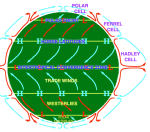Global circulation of air and water influenced by factors such as latitude, land and sea size, altitude, and albedo determines climatic conditions. It explains, for instance, why the Atacama Desert is so dry. Melting sea ice and warming Polar Regions will alter circulation. What comes next? And when does it arrive?
 Originally posted on robertscribbler:
Originally posted on robertscribbler:
Atop the world lies a thinning veil of ice. A gossamer lid covering a deep, dark Arctic Ocean. It is a reflector screen for incoming solar radiation during the months-long-day of Polar Summer. And a recent NASA study shows that this heat shield is starting to fail.
Ever since the late 1970s an Arctic warming at 2-3 times the rate of the rest of the globe has set off a 13.3 percent decline of sea ice at end summer during each and every following decade. And that cumulative loss is having an extraordinary impact. For the white, reflective ice cover by September has now, on average, fallen by nearly 50%. What remains is a thinner ice cover. One full of holes and interspersed with great and widening expanses of dark water.
Dark water and thinner, less contiguous, ice absorbs more of the sun’s heat. NASA notes that this added absorption…
View original 827 more words

 Global circulation of air and water influenced by factors such as latitude, land and sea size, altitude, and albedo determines climatic conditions. It explains, for instance, why the Atacama Desert is so dry. Melting sea ice and warming Polar Regions will alter circulation. What comes next? And when does it arrive?
Global circulation of air and water influenced by factors such as latitude, land and sea size, altitude, and albedo determines climatic conditions. It explains, for instance, why the Atacama Desert is so dry. Melting sea ice and warming Polar Regions will alter circulation. What comes next? And when does it arrive?
